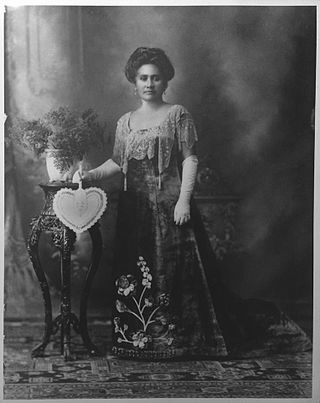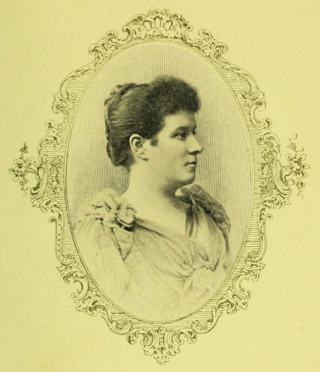Mary Theresa McKee Waggaman, was an American author of Catholic literature in the early 20th century who was primarily known for writing short stories for children.
Mary Theresa McKee Waggaman, was an American author of Catholic literature in the early 20th century who was primarily known for writing short stories for children.
Waggaman was born on September 21, 1846, to John and Ester (Cottrell) McKee. [1] She was from Baltimore and attended Mount de Sales Academy in Catonsville, Maryland. [2] [3] Her mother died when she was young, and she moved with her father to New York during the American Civil War. [1] Her father was arrested because of his support for the American South, and Waggaman would write "An American Bastile" about her experiences during the Civil War that was published in Ave Maria. [4] [5] After the Civil War she returned to Mount de Sales Academy and was valedictorian of her class in 1864. [1]
As early as 1871 Waggaman was a published writer, starting with a poem in the January 1972 issue of Harper's Magazine . [6] [7] Waggaman's first short story was "Little Comrades" which she wrote to impress upon her first son the importance of his First Communion. [8] While Waggaman initially did not share that she received funds for her writing, [5] : 273 she eventually described how she was able to earn enough money from her writing to hire a nurse and servants who enabled her to write each day. [8]
Waggaman is known for her writings for children and her writing for Catholic periodicals. [9] She published under different names, using "Fannie Fairie" for serials and "Queerquill" for poems. [5] : 273
{{cite book}}: |website= ignored (help)In 1923 Waggaman won first prize for a story she submitted to the Columbian magazine published by the Knights of Columbus. [15] There were 3,000 authors competing for this honor. [5] : 275
Waggaman married Samuel J. Waggaman in 1870. [1] Together they had eleven children, [8] six of whom were alive upon her death in 1931. [16] One daughter, also named Mary T. Waggaman, achieved recognition as a poet. [17] In 1942, her daughter Ester W. Neill, who was also a writer, [5] : 207–209 wrote about her mother in The Book Of Catholic Authors First Series. [5] : 270–276

Pamela Lyndon Travers was an Australian-British writer who spent most of her career in England. She is best known for the Mary Poppins series of books, which feature the eponymous magical nanny.

Gerty Theresa Cori was an Austrian-American biochemist who in 1947 was the third woman to win a Nobel Prize in science, and the first woman to be awarded the Nobel Prize in Physiology or Medicine, for her role in the "discovery of the course of the catalytic conversion of glycogen".

Mary Hallock Foote (1847–1938) was an American author and illustrator. She is best known for her illustrated short stories and novels portraying life in the mining communities of the turn-of-the-century American West.

Theresa Owana Kaʻōhelelani Laʻanui was a descendant of Kalokuokamaile, the eldest brother of Kamehameha I. She was a member of the House of Laʻanui, a collateral branch of the House of Kamehameha.

Mary Roberts Rinehart was an American writer, often called the American Agatha Christie. Rinehart published her first mystery novel The Circular Staircase in 1908, which introduced the "had I but known" narrative style. Rinehart is also considered the source of "the butler did it" plot device in her novel The Door (1930), although the exact phrase does not appear in her work. She also worked to tell the stories and experiences of front line soldiers during World War I, one of the first women to travel to the Belgian front lines.

Mary Anne Sadlier was an Irish author. Sadlier published roughly twenty-three novels and numerous stories. She wrote for Irish immigrants in both the United States and Canada, encouraging them to attend mass and retain the Catholic faith. In so doing, Sadlier also addressed the related themes of anti-Catholicism, the Irish Famine, emigration, and domestic work. Her writings and translations are often found under the name Mrs. J. Sadlier. Earlier in her career, from 1840 to 1845, some of her works were published under the name "Anne Flinders".

RCL Benziger is a Roman Catholic book-publishing house founded in 1792 by Joseph Charles Benziger in Einsiedeln, Switzerland. It is currently based in Cincinnati, Ohio, and operates as a subsidiary of Kendall Hunt Publishing.

Elizabeth Robins Pennell was an American writer who, for most of her adult life, made her home in London. A researcher summed her up in a work published in 2000 as "an adventurous, accomplished, self-assured, well-known columnist, biographer, cookbook collector, and art critic"; in addition, she wrote travelogues, mainly of European cycling voyages, and memoirs, centred on her London salon. Her biographies included the first in almost a century of the proto-feminist Mary Wollstonecraft, one of her uncle the folklorist Charles Godfrey Leland, and one of her friend the painter Whistler. In recent years, her art criticism has come under scrutiny, and her food criticism has been reprinted.
James Aloysius Griffin was an American prelate of the Roman Catholic Church. He served as bishop of the Diocese of Springfield in Illinois from 1924 until his death in 1948.

Anna Hanson Dorsey was an American author of novels and short stories. A convert to Catholicism, she was a pioneer of Catholic literature in the United States.

Rosa Mulholland, Lady Gilbert was an Irish novelist, poet and playwright.

M. Maryan was the pseudonym used by Marie Rosalie Virginie Cadiou (1847-1927), a French novelist born in Brest who worked in Paris. She was a prolific author who wrote for young female readers.

Mary F. Nixon-Roulet was an author of books for children and Christian audiences in the late 19th and early 20th century. She wrote numerous biographies of Catholic saints, and her work was regularly promoted in Catholic and Presbyterian publications and in the popular press. She also was a regular contributor to the "Our Little Cousin..." series, writing volumes including Our Little Spanish Cousin; Jean, Our Little Australian Cousin; Kalitan, Our Little Alaskan Cousin; and others for the publisher L.C. Page & Co. The series offered children of the time "delightful descriptions in story form of the life of the children of all these countries." She also wrote a book of Japanese fairy tales and published short stories in compilations and publications like the New-York Tribune.

Anna T. Sadlier was a Canadian writer whose novels were of a Catholic nature, and whose works numbered over forty volumes. She began to write when she was about eighteen. Her published works include a number of translations from the French, Italian, and Spanish. Sadlier died in 1932.

Louisa Emily Dobrée was a 19th-century-born French-Irish Catholic writer of novels, fugitive articles, short stories, and juvenile literature. Her non-fiction subjects ranged from home nursing, domestic and personal hygiene, etiquette, character sketches, and embroidery, to natural history.

Mrs. Bartle Teeling was a British writer. She published dozens of articles and biographical sketches, as well as several books, a play, and some music. Teeling died in 1906.

Clara Mulholland (1849–1934) was a writer who was born in Belfast but moved to England at an early age. In addition to being a prolific novelist since the 1880s, she wrote children's literature, plays, and was a translator from French into English.

Honoré Willsie Morrow was an American novelist and short story writer, as well as a magazine editor. Traveling to every state of the Union with her first husband, she used these experiences as background for her writing. Morrow is remembered for what became known as The Great Captain trilogy centered upon Abraham Lincoln: Forever Free (1927), With Malice Toward None (1928), and The Last Full Measure (1930). For five years, she served as the editor of The Delineator.
Mary Gay Humphreys was an American journalist and author. She is best known for her writings in multiple news outlets, and her books including one on Catherine Schuyler, a socialite in Colonial America.
Mary Myrtle Tye (1886–1933) was an American medical librarian from Atlanta, Georgia, who became the first librarian of the Abner Wellborn Calhoun Medical Library at Emory University, later renamed the Woodruff Health Sciences Center Library.